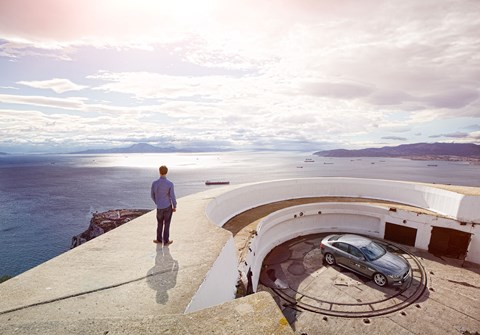► Jaguar XE feature review by CAR magazine
► We drive 1351 miles from Portugal to Gibraltar
► Follow our road trip in XE 2.0D 180ps R-Sport
Sit down with the Jaguar XE’s engineers and they’ll talk about the 50-metre test: those first moments behind the wheel where a car begins to reveal its character; the weight of the steering, the sound of the engine, the touch of the controls. Even if your mind is elsewhere, those mental impressions are subconsciously forming.
I blip the keyfob – one of the few not-new things on the XE – and climb into Jaguar’s crucial new BMW 3-series rival. What do you notice during that 50-metre handshake? The relatively low-slung driving position, the steering that feels tight and precise immediately off-centre, the easy torque and unpleasing mew of the new Ingenium 2.0-litre turbodiesel engine in low gears, and the way the chassis – even on our car’s R-Sport suspension and 19-inch alloys – anaesthetises little speedbumps.
It’s true, those first metres are revealing, but over the next two days we’re planning something more comprehensive: a 1350-mile marathon.
We’ll drive from Lisbon, Portugal, over challenging mountain roads in the north of the country, tip-toe over snow-covered passes, blast into Spain along deserted autoroutes, crawl through rush-hour traffic and cruise south down the east Atlantic coast.
When we finally knock off the engine we’ll be staring out over the Mediterranean from Gibraltar, 6.5km of strategically important triangular rock that helped Britain win the war. The XE’s built in Solihull, it’s gunning for the Germans, and that’s a good enough metaphor to merit a 1350-mile jaunt for me.
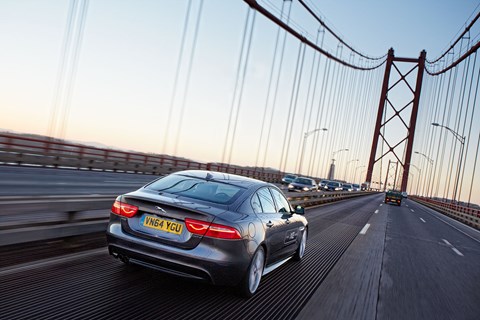
The XE puts Jaguar back in the D-segment for the first time since the X-type downed tools in 2010. That car found 364,098 buyers in eight years, but its shared Mondeo DNA was mud that stuck to Jaguar’s image, unlike the way it simply washes off VW Group with its Skoda to Audi commonality.
This residual tarnish means Jaguar must over-compensate with the XE; it needs to give customers a compelling reason to step away from cars they typically default to: the Audi A4, Mercedes C-class and, of course, class-leading BMW 3-series.
Aluminium tech: the lightweight Jaguar XE story
On paper, it has: the XE is the only car in its segment with an aluminium-intensive bodyshell – not full aluminium, but 75% – and double-wishbone front suspension; all-new, all-aluminium turbodiesel engines emit as little as 99g/km; it’s competitively priced and equipped, and – subjective, this – it looks bloody good.
The XE also claims to be the driver’s car in its class, and if Jaguar can make a car that’s a better steer than an ultimate driving machine it’s really onto something. So we wake early and head for the Serra da Estrela, home to Portugal’s highest mountain range and some of its most challenging roads.
The autoroute leads out of Lisbon, and cuts through dense, lush green forest like some vast concrete tsunami unfurling into the distance. There’s little traffic, so we settle at a fast cruise.
Our car is a pre-production prototype, a nice little catch-all for nervy manufacturers, but this really is an early car: the VIN number is a line of zeros with 16 tacked on the end, some of the leather on the dash looks taken from the cow after a scuffle – we’re promised production cars will be better, and current products give us confidence in that assertion – and there’s a large red mushroom in one of the cupholders; the ECU is so new that it hasn’t been fully approved yet, so the emergency button’s a legal requirement.
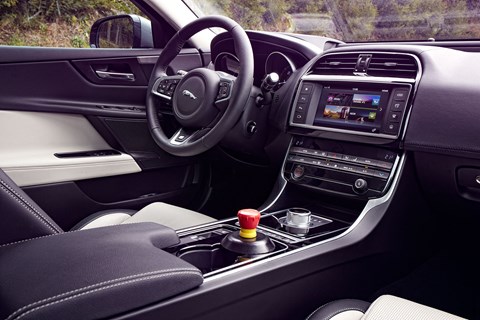
We’re driving the 178bhp/317lb ft 2.0-litre turbodiesel, the top of two four-cylinder TD engines at launch. A 163bhp turbodiesel starts from £29,775, the 178bhp motor £500 more, but in R-Sport Auto trim our car costs £34,775. Four-cylinder petrols follow from £26,995, but neither they nor the launch V6 hail from the modular Ingenium family; they’re carryover units.
If you miss the relative refinement of a six-pot turbodiesel at low speeds, you certainly don’t when the engine spins freely on the autoroute. The grumble vanishes, and its large reserves of torque whoosh the XE along so effortlessly that it feels positively narcoleptic at 110mph.
Better still, the all-aluminium Ingenium pairs much more convincingly with the eight-speed auto than the old 2.2-litre turbodiesel in big-brother XF. That set-up feels too keen to reach eighth gear, then too hasty to drop right back down at the merest flex of ankle. The XE still fast-forwards to eighth, but it’ll hold higher gears when you floor the throttle, presumably a combination of refined mapping and the Ingenium’s better low-down torque.
After a couple of hours, we spear off down a tight sliproad and get a sneak preview that the XE is something special; it hooks into the bend with a confidence-inspiring agility that encourages you to keep the throttle pinned, and all the while there’s a fairly long-travel flow to the suspension that reassures you that no expansion joint will spit it off line.
Jag XE handling: in the snow
We crawl through Covilha and out into country above, where the minor roads are damp and snake up into snow-covered hills in a constant stream of hairpins and fast, flowing kinks.
The XE quickly finds a rhythm, revealing how incisively its front end responds to steering inputs. It encourages you to attack harder into corners, where you sense that the Dunlops’ contact patch is no more compromised than it would be in a straight line; it feels like you’ll run out of road before you run out of tyre.
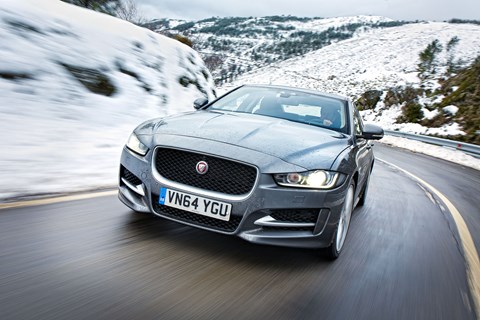
Partly it’s that stiff aluminium structure, partly the unique-in-segment double-wishbone front suspension shared with F-type. The steering instils confidence too. It’s Jaguar’s first electrically assisted system, and it offers excellent precision from the straight-ahead, bantamweight agility, and a progressive increase in loading that winds off with natural self-centering. I think I prefer the lightness of Normal mode, but it’s a credit to the tuning that Dynamic is equally useable on the road and doesn’t feel like a hydraulic rack that’s had a power-steering belt failure at the apex. There’s steering feel too, if scope for much more.
I make a few runs up and down the road with a smile plastered all over my face, but all too soon there’s a stench in the car and smoke signals from the pads. This might be atypical use, but the chassis encourages a hard-driving style that finds the brakes wanting. Better than a 3-series? We need a back-to-back to be sure, but gut-feel is yes, by a margin.
A mild panic over our mileage has unleashed an armada of JLR support vehicles to shadow us, providing the opportunity to jump into the top-spec £45k S with its 3.0-litre V6 supercharged engine. Naturally, it sounds much better with its gentle purr at idle, a welcome respite after the Ingenium’s sticky, noisy ticking, and the V6’s warbly howl under acceleration really eggs you on.
The S’s extra power – all 335bhp and 332lb ft of it – and larger brakes also make the drive more intense, because you can work the rear-drive chassis so much harder. Yet the 2.0TD is almost equally enjoyable, and the two cars appear near identical; I bet S owners will wish the company reps didn’t look so sharp and weren’t having so much fun.
All Surface Progress Control: a real test
Above 1200 metres, the wet turns to slush and then snow. It’s the perfect environment to test All Surface Progress Control (ASPC), a new feature based on Land Rover technology and one that could help the XE score heavily over rear-drive rivals. Press a button on the centre console, set a low speed through the cruise-control buttons, and the Jag is supposed to find the traction that a human can’t.
Not up here it doesn’t. I pull over onto a snow-covered layby on an uphill incline and immediately become stranded. The XE rocks as the torque shuffles aggressively back and forth across the axle, trying to find purchase with the summer tyres, but it won’t budge; the only thing squirming more than the Jag’s rear end is the PR in the passenger seat.
Where ASPC really scores is as a Hill Descent Control system when you’re tip-toeing down an icy hill wondering if you’ll pinball to the bottom. It’s a very welcome comfort blanket in those situations.
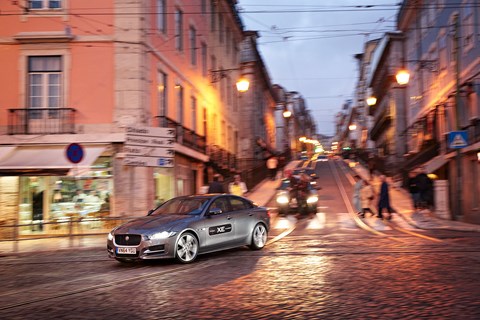
We’re back in Lisbon in time to head through rush-hour traffic. We criss-cross the uneven cobbles, get that gut-twisting panic when we (legally) drive down tram tracks, make three-point turns in tight spaces and queue at endless red lights.
The auto ’box glides through the first of its eight ratios, the ride is settled over all but the harshest surfaces – there’s some clatter from the new Integral Link rear axle on really bad cobbles – chunky D-pillars make the optional reversing camera a near-necessity, and the turning circle is handily tight.
Queuing traffic provides a perfect opportunity to experience the new InControl Touch infotainment system. The eight-inch touchscreen brings sat-nav across the range, and at last provides Jaguar with a more intuitive system. Steps between functions are greatly reduced, phones are paired painlessly, entering addresses requires no IT helpdesk. I have two gripes: the four blocks on the homescreen – audio, climate, sat-nav and phone – aren’t as easily distinguished as they could be, particularly the climate and sat-nav functions, and it’s still easier to zoom in on a map using a rotary dial than it is prodding your finger at a screen in a moving car. But huge improvement.
Day two: from Lisbon to Spain
We’re up early again the next morning, heading over Lisbon’s Golden-Gate-a-like suspension bridge and towards Spain. We’ve got a hell of a lot of miles to blitz, so we don’t hang about.
Even at very high speed the XE remains an incredibly refined car, with hushed wind noise and a pillowy ride. It’s also freakishly planted, seeming almost immune to crosswinds – presumably another benefit of that clever electric power-steering tuning – without coming over all aloof.
We drive into the burning orange sun as it rises up ahead, past Faro and Seville, the roads empty as the needle hovers around 100-110mph. Even at these speeds, the fuel gauge proves surprisingly stoic; Jaguar claims up to 67.3mpg, and the fuel computer reveals we’re averaging 34mpg, which is excellent given the caning meted out.
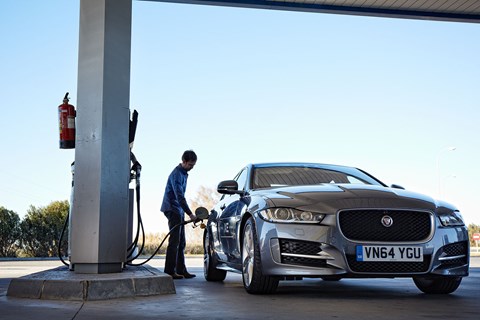
We stop to refuel after four hours, and I bound out with no numb bum, no sore back, no stiffness… but after all that time staring at the dash I’m starting to find fault with the interior.
The swoop that flows from the dash-top straight into the door casings is pure XJ, but it creates a busy interface where the two sections meet and leaves the air-vent treatment looking clunky. The touchscreen works well, but the side-effect of having it in easy reach of prodding fingers is an ugly tombstone dominating the dash centre. The rotary gear controller looks lost in the centre console – the F-type’s shifter would be far more indicative of excellent dynamics – and Jaguar continues to field a steering wheel with oversized spokes that resist your hands like a blind-date with a change of heart. The cheap-feeling paddleshifters are also positioned right where you want to rest your fingers; I hold the rim above the spokes and use my little finger to tap the paddles, coming over all Queen-drinking-a-cuppa. There’s more too: the head- and armrests are too firm; the ambient lighting too 1990s cocktail bar; the switch for choosing driving modes too fiddly…
The XE is still, ultimately, a nice place to be, but it’s easy to find fault here where the drive results in a blank notepad. What about the practical stuff that’s essential for junior execs… the boot space, the legroom? The boot holds 450 litres (30 fewer than 3-series/C-class/A4), and that sloping roofline means you must duck under it to climb in, and parents will find it a little harder to belt kids into child seats; an estate would remove both hurdles, but the engineers remain surprisingly coy about its existence – they’re not planning a junior F-Pace, perchance? There is room for four six-footers in the back of the XE, but I’m 6ft 1in and my hair brushes the headlining, and my knees touch the scalloped seatbacks with their solid plastic centres. I could sit here all day with only muffled griping, but take note if you’ve sired giant offspring.
Back on the road, the speed creeps a little higher with the finish in sight. Given Spain’s annoyance at Britain’s hold on Gibraltar, it’s unsurprising that the only mention of the G word is a sign that points us off the autoroute when we can already see the Rock poking out of the Med like a giant shark fin.
Destination: Gibraltar
There’s a proper border crossing from Spain into Gibraltar, and legend has it that the queues last hours. We’re through in 15 minutes, pulled over by the bizarrely familiar sight of a British bobby who comments on the ‘lovely car’ and sends us on our way.
We drive down Winston Churchill Avenue, over the airport runway that bisects it – getting buzzed by an aggressively driven 1980s Seat Panda on Spanish plates – and on towards the Rock that looms above us. Seeing the familiar transposed into southern Europe instantly jars in a weird dream-like reality: seemingly stereotypical Spanish girls on scooters brandish burgundy British passports; road signs in English bear the same font and layout as you’ll find back home; everything’s in sterling, including the petrol-station totem poles (down to around 90p a litre if you go the extra mile for the best deal); numberplates echo our white-up-front/yellow-out-back logic, but with a ‘G’ and a few numbers. It almost feels wrong to be driving on the right of the road.
Thirty thousand inhabitants squeeze onto this tiny outcrop and space is at a premium: houses cram together row-after-row, scooters park in endless lines down side streets, and dredging continues to reclaim land to ease demand. We thread through narrow streets before discovering the road that heads straight up to the Rock. Part-way up there’s a turn-off and a ticket barrier: £10 per car, £2 per person.
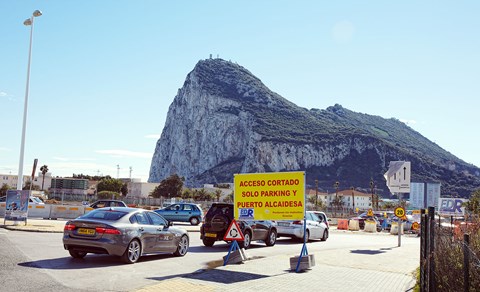
Beyond the barrier a thin road cut out of the rockface by the Royal Anglian Regiment spears steeply upwards, just a few painted white stones and a loose covering of foliage shrouding a hefty tumble into the harbour below.
The Rock might create further pressures on Gibraltar’s precious square metres, but the geography was quickly exploited by the military: far below us, the British carved a vast network of tunnels and control rooms out of the limestone; up above, the Rock’s 426-metre elevation provides commanding views of the Straight Of Gibraltar, that crucial little bottleneck between the Atlantic and the Mediterranean Sea.
The road climbs up and up, past Barbury macaques whose behaviour swings between fierce in-fighting and mournfully contemplative glances at tourists, and on towards Spur Battery, a large artillery base that once made enemy vessels cower with its 9.2-inch gun’s 27,000-metre range.
Today, the gun is gone, displayed at the Duxford Air Museum back home, so we’re able to park the XE right on the spot where that gun once wheeled left to right scanning the horizon, from Spain to Africa and out into the Atlantic.
It’s been an amazing road trip and the best possible introduction to this crucial new car. The opposition won’t be a walkover for the XE, but up here in this little corner of Britain far from home, the most important Jaguar in decades certainly feels ready to take on the world.
This feature originally appeared in the March 2015 issue of CAR magazine. Click here to find out more about CAR and our best subscription deals for print and digital editions
